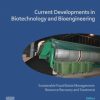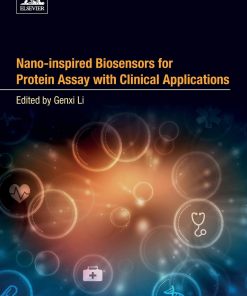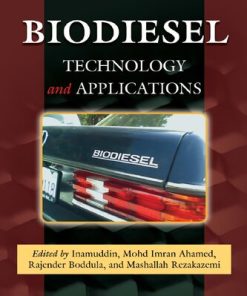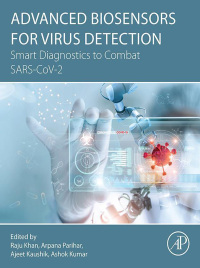(Ebook PDF) Advanced Biosensors for Health Care Health Care 1st edition by Inamuddin, Raju Khan, Ali Mohammad, Abdullah Asiri 0128165227 9780128165225 full chapters
$50.00 Original price was: $50.00.$25.00Current price is: $25.00.
Advanced Biosensors for Health Care Applications 1st edition by Inamuddin, Raju Khan, Ali Mohammad, Abdullah M. Asiri – Ebook PDF Instant Download/DeliveryISBN: 0128165227, 9780128165225
Full dowload Advanced Biosensors for Health Care Applications 1st edition after payment.

Product details:
ISBN-10 : 0128165227
ISBN-13 : 9780128165225
Author: Inamuddin, Raju Khan, Ali Mohammad, Abdullah M. Asiri
Advanced Biosensors for Health Care Applications highlights the different types of prognostic and diagnostic biomarkers associated with cancer, diabetes, Alzheimer’s disease, brain and retinal diseases, cardiovascular diseases, bacterial infections, as well as various types of electrochemical biosensor techniques used for early detection of the potential biomarkers of these diseases. Many advanced nanomaterials have attracted intense interests with their unique optical and electrical properties, high stability, and good biocompatibility. Based on these properties, advanced nanoparticles have been used as biomolecular carriers, signal producers, and signal amplifiers in biosensor design. Recent studies reported that there are several diagnostic methods available, but the major issue is the sensitivity and selectivity of these approaches.
Advanced Biosensors for Health Care Applications 1st Table of contents:
Chapter 1. Advanced Nanoparticle-Based Biosensors for Diagnosing Foodborne Pathogens
Abstract
1.1 Introduction
1.2 Types of Bioreceptors
1.3 Types of Transducers
1.4 Membrane-Based Biosensors
1.5 Multiplex Biosensors
1.6 Performance of Nanoparticle-Based Biosensors
1.7 Conclusion and Future Perspectives
Acknowledgments
References
Chapter 2. Aptamer Technology for the Detection of Foodborne Pathogens and Toxins
Abstract
2.1 Introduction
2.2 Detection of Foodborne Pathogens
2.3 Biosensors
2.4 Classification of Aptamer-Based Biosensors
2.5 Conclusion
Competing Financial Interest
References
Chapter 3. Biosensors for Rapid Detection of Breast Cancer Biomarkers
Abstract
3.1 Introduction
3.2 Biosensors
3.3 Biosensors for Rapid Breast Cancer Detection
3.4 Conclusion
References
Chapter 4. Electrochemical Biosensors for Antioxidants
Abstract
4.1 Introduction
4.2 Biosensors for the Determination of Reactive Oxygen Species
4.3 Electrochemical Biosensors for the Assessment of Total Antioxidant Capacity of Plants and Foods
4.4 Biosensors for the Analysis of Polyphenols in Beverages
4.5 Conclusion
4.6 Acknowledgments
References
Chapter 5. Electrochemical Immunosensors for Rapid Detection of Breast Cancer Biomarkers
Abstract
5.1 Introduction
5.2 Electrochemical Immunosensing of Breast Cancer Protein Biomarkers
5.3 Future Prospects and Challenges
5.4 Conclusion
Acknowledgment
References
Chapter 6. Functionalized Advanced Hybrid Materials for Biosensing Applications
Abstract
6.1 Introduction
6.2 Advanced Inorganic Hybrid Materials
6.3 Advanced Organic–Inorganic Hybrid Materials
6.4 Advanced Organic Hybrid Materials
6.5 Optical Multifunctional Advanced Hybrid Materials
6.6 Conclusion
References
Chapter 7. Smart, Portable, and Noninvasive Diagnostic Biosensors for Healthcare
Abstract
7.1 Introduction
7.2 Wearable Sweat Sensors
7.3 Gas Sensors for Healthcare
7.4 Future Perspectives
7.5 Conclusion
References
Chapter 8. Aptamer-Mediated Nanobiosensing for Health Monitoring
Abstract
8.1 Introduction
8.2 Biosensors
8.3 Types of Nanobiosensors
8.4 Conclusion
Competing financial interest
References
Chapter 9. Biosensing–Drug Delivery Systems for In Vivo Applications
Abstract
9.1 Introduction
9.2 Adaptation of Biosensing–Drug Delivery Systems to In Vivo Applications
9.3 Materials and Devices Used as Biosensing–Drug Delivery Systems
9.4 Case Studies
9.5 Conclusion
References
Chapter 10. Nanobodies and Their In Vivo Applications
Abstract
10.1 Introduction
10.2 Heavy-Chain-Only Antibodies Generation
10.3 Drawbacks of Monoclonal Antibodies
10.4 Nanobody Characteristics Making Them Suitable for Therapeutic Application
10.5 Nanobodies Binding to Transmembrane Proteins
10.6 Application of Nanobodies in Medical Imaging
10.7 Inflammatory Diseases
10.8 Chronic Respiratory Diseases
10.9 Application of Nanobodies Against Viruses
10.10 Application of Nanobodies Against Bacteria
10.11 CONCLUSION
References
Chapter 11. New Micro- and Nanotechnologies for Electrochemical Biosensor Development
Abstract
11.1 Introduction
11.2 Microfluidics Chips
11.3 Quantum Dots
11.4 Graphene
11.5 Graphitic Carbon Nitride (g-C3N4) Based Nanomaterials
11.6 Conclusion
References
Chapter 12. Cholesterol-Based Enzymatic and Nonenzymatic Sensors
Abstract
12.1 Introduction
12.2 Cholesterol Absorption
12.3 Enzymatic Sensors
12.4 Nonenzymatic Sensors
12.5 Future Prospects
12.6 Conclusion
References
Chapter 13. Recent Trends in Sensors for Health and Agricultural Applications
Abstract
13.1 Introduction
13.2 Smart Health Sensors
13.3 Smart Agriculture Sensors
13.4 Global Market for Smart Sensors
13.5 Future Prospects
13.6 Conclusion
References
Chapter 14. Hybrid Carbon Nanostructures for Chemical and Biological Sensors
Abstract
14.1 Introduction
14.2 Synthesis of 3D Structured Graphene Nanosheets
14.3 Graphene-Based Electrochemical Sensors and Electrodes for Detecting Biomolecules
14.4 Conclusion
References
Further Reading
Chapter 15. Challenges and Future Prospects of Nanoadvanced Sensing Technology
Abstract
15.1 Introduction
15.2 Nanomaterial-Based Biosensors and Chemical Sensors
15.3 Nanostructures, Nanoparticles, Nanowires, Nanofibers, and Nanoprobes
15.4 Tubular and Porous Nanostructures
15.5 Metal Nanomaterials
15.6 Metal Oxide Nanomaterials
15.7 Carbon-Based Nanomaterials
15.8 Polymer Nanomaterials
15.9 Biological Materials
15.10 Conclusion
People also search for Advanced Biosensors for Health Care Applications 1st:
advantages of biosensors
advantages and disadvantages of biosensors
why are biosensors important
advanced biosensors
biosensors in healthcare
You may also like…
Medicine
India’s Public Health Care Delivery: Policies for Universal Health Care 1st Edition Sanjeev Kelkar
Uncategorized
(eBook PDF) Advanced Health Assessment & Clinical Diagnosis in Primary Care 6th Edition
Technique - Nanotechnology
Science (General)
Computers - Networking
Medicine - Molecular Medicine
Advanced Biosensors for Virus Detection – Smart Diagnostics to Combat SARS-CoV-2 1st Edition
Engineering
Chemical, Gas, and Biosensors for Internet of Things and Related Applications Kohji Mitsubayashi











